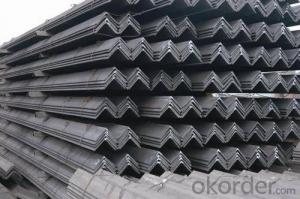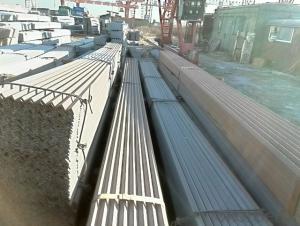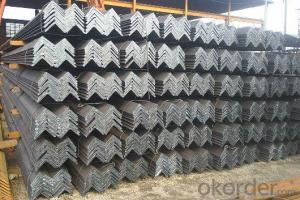Hot Rolled Steel Angles with Good Quality
- Loading Port:
- Tianjin
- Payment Terms:
- TT OR LC
- Min Order Qty:
- 25 m.t.
- Supply Capability:
- 20000 m.t./month
OKorder Service Pledge
OKorder Financial Service
You Might Also Like
Product Description:
OKorder is offering high quality Hot Rolled Steel Angles at great prices with worldwide shipping. Our supplier is a world-class manufacturer of steel, with our products utilized the world over. OKorder annually supplies products to European, North American and Asian markets. We provide quotations within 24 hours of receiving an inquiry and guarantee competitive prices.
Product Applications:
Hot Rolled Steel Angles are ideal for structural applications and are widely used in the construction of buildings and bridges, and the manufacturing, petrochemical, and transportation industries.
Product Advantages:
OKorder's Hot Rolled Steel Angles are durable, strong, and resist corrosion.
Main Product Features:
· Premium quality
· Prompt delivery & seaworthy packing (30 days after receiving deposit)
· Corrosion resistance
· Can be recycled and reused
· Mill test certification
· Professional Service
· Competitive pricing
Product Specifications:
Manufacture: Hot rolled
Grade: Q195 – 235
Certificates: ISO, SGS, BV, CIQ
Length: 6m – 12m, as per customer request
Packaging: Export packing, nude packing, bundled
Sizes: 25mm-250mm | ||
a*t | ||
25*2.5-4.0 | 70*6.0-9.0 | 130*9.0-15 |
30*2.5-6.6 | 75*6.0-9.0 | 140*10-14 |
36*3.0-5.0 | 80*5.0-10 | 150*10-20 |
38*2.3-6.0 | 90*7.0-10 | 160*10-16 |
40*3.0-5.0 | 100*6.0-12 | 175*12-15 |
45*4.0-6.0 | 110*8.0-10 | 180*12-18 |
50*4.0-6.0 | 120*6.0-15 | 200*14-25 |
60*4.0-8.0 | 125*8.0-14 | 250*25 |
FAQ:
Q1: Why buy Materials & Equipment from OKorder.com?
A1: All products offered byOKorder.com are carefully selected from China's most reliable manufacturing enterprises. Through its ISO certifications, OKorder.com adheres to the highest standards and a commitment to supply chain safety and customer satisfaction.
Q2: How do we guarantee the quality of our products?
A2: We have established an advanced quality management system which conducts strict quality tests at every step, from raw materials to the final product. At the same time, we provide extensive follow-up service assurances as required.
Q3: How soon can we receive the product after purchase?
A3: Within three days of placing an order, we will begin production. The specific shipping date is dependent upon international and government factors, but is typically 7 to 10 workdays.
Images:
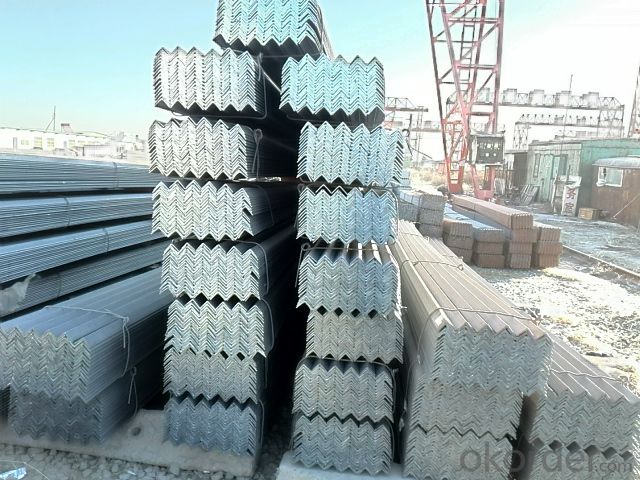
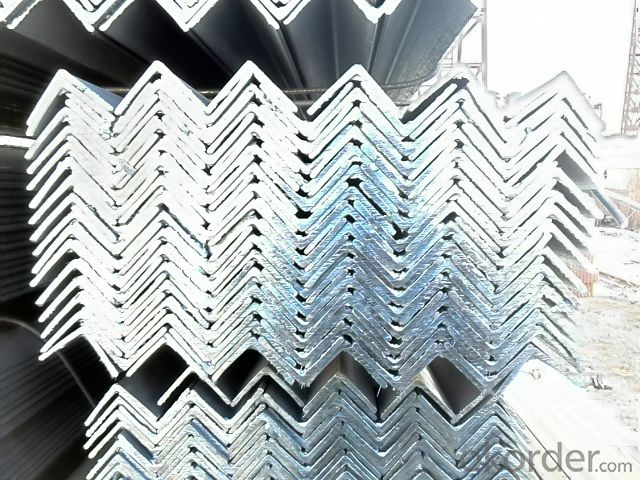

- Q:Can steel angles be used for pipe supports?
- Yes, steel angles can be used for pipe supports. Steel angles provide structural strength and stability, making them suitable for supporting pipes and ensuring their stability and alignment.
- Q:What is the typical thickness of the legs of a steel angle?
- The specific application and requirements can cause variation in the typical thickness of steel angle legs. Generally, standard thicknesses for steel angles are diverse, typically ranging from 1/8 inch to 1 inch. The legs of a steel angle usually have uniform thickness, meaning both legs possess the same thickness. It is worth mentioning that for specialized or custom applications, thicker or thinner legs can be produced to fulfill specific needs. For more accurate information on the typical thickness of steel angle legs for specific applications, it is advisable to refer to consulting engineering specifications or industry standards.
- Q:Can steel angles be fire-resistant?
- Yes, steel angles can be fire-resistant. Steel, as a material, has inherent fire-resistant properties due to its high melting point and low thermal conductivity. When exposed to high temperatures, steel angles can maintain their structural integrity and resist deformation for a considerable amount of time. Additionally, steel angles can be further enhanced for fire resistance through various methods such as applying fire-resistant coatings or incorporating fire-resistant materials in their design. These measures help to increase the fire resistance of steel angles, making them suitable for applications where fire protection is necessary, such as in the construction of fire-resistant walls, ceilings, and structural systems.
- Q:Can steel angles be used for structural applications?
- Indeed, structural applications can make use of steel angles. Due to their strength, durability, and versatility, steel angles are frequently employed in construction and engineering endeavors. The convenience of welding, bolting, or otherwise connecting them to other steel components makes them particularly valuable for providing structural support and stability. Frames, supports, braces, and reinforcements often incorporate steel angles. Moreover, their shape and design enable efficient load-bearing capabilities, rendering them suitable for a wide range of structural applications including bridges, buildings, towers, and industrial structures. In summary, steel angles present a dependable and budget-friendly option for structural applications.
- Q:What are the different surface finishes available for painted steel angles?
- There are several different surface finishes available for painted steel angles, depending on the desired aesthetic and functional requirements. 1. Smooth finish: This is the most common surface finish and provides a smooth and even appearance. It is achieved by applying a coat of paint evenly over the steel surface, followed by a curing process to ensure durability. 2. Textured finish: Textured finishes provide a rougher surface with a pattern or texture. This can be achieved through different techniques such as sandblasting or using textured paint. Textured finishes can enhance the grip and make the steel angle less slippery, making it suitable for applications where traction is important. 3. Matte finish: A matte finish has a low sheen or gloss level, resulting in a non-reflective surface. This finish is often preferred for applications where a more subdued appearance is desired. 4. Glossy finish: A glossy finish, on the other hand, has a high sheen or gloss level, providing a reflective and shiny surface. It can give a more polished and visually appealing look to the painted steel angle. 5. Powder-coated finish: Powder coating is a popular method for providing a durable and long-lasting surface finish. The steel angle is first coated with a dry powder, which is then cured under heat to form a hard and protective layer. Powder-coated finishes offer excellent resistance to scratches, chemicals, and UV rays. 6. Galvanized finish: Galvanization is a process in which a layer of zinc is applied to the steel surface, providing corrosion resistance. While galvanized steel angles are not typically painted, they can be painted over if desired, allowing for various color options. In summary, the different surface finishes available for painted steel angles include smooth, textured, matte, glossy, powder-coated, and galvanized finishes. The choice depends on the intended use, desired appearance, and the level of durability required for the application.
- Q:What are the load-bearing capacities of different steel angle sizes?
- The load-bearing capacities of various steel angle sizes differ based on multiple factors, such as the material grade, angle size, and angle length. Generally, larger steel angle sizes possess higher load-bearing capacities in comparison to smaller sizes. To determine the load-bearing capacity of a particular steel angle size, it is crucial to take into account its moment of inertia, which measures its resistance to bending. The moment of inertia increases as the angle size becomes larger, resulting in higher load-bearing capacities. Furthermore, the yield strength of the steel used in the angle also plays a significant role in determining its load-bearing capacity. Yield strength refers to the maximum stress that a material can endure without undergoing permanent deformation. Steel angles with higher yield strength can support heavier loads. To obtain accurate load-bearing capacity information for different steel angle sizes, it is important to consult engineering resources such as steel design manuals or structural engineers. These resources provide tables and formulas that consider the specific dimensions and properties of the angle, allowing for the calculation of the maximum allowable load it can safely bear. In conclusion, the load-bearing capacities of various steel angle sizes depend on factors including angle size, material grade, and yield strength. It is necessary to consult reliable engineering resources to obtain accurate load-bearing capacity information for specific steel angle sizes.
- Q:Are steel angles resistant to wind loads?
- Yes, steel angles are generally resistant to wind loads due to their high strength and structural integrity.
- Q:Are there any environmental concerns related to the production or disposal of steel angles?
- Yes, there are environmental concerns related to the production and disposal of steel angles. The production of steel angles involves energy-intensive processes that contribute to greenhouse gas emissions and air pollution. Moreover, the extraction of raw materials for steel production can lead to habitat destruction and ecosystem disruption. Additionally, if steel angles are not properly disposed of, they can contribute to waste accumulation and potential environmental contamination.
- Q:How do you calculate the bending stress in a steel angle?
- To calculate the bending stress in a steel angle, you can use the formula σ = (M * c) / I, where σ is the bending stress, M is the bending moment, c is the distance from the centroid to the extreme fiber, and I is the moment of inertia.
- Q:What are the different types of steel angles used in automotive manufacturing?
- Automotive manufacturing relies on a variety of steel angles that play a crucial role in designing and constructing automotive structures and parts. Some of the commonly utilized steel angles in this industry include: 1. Equal Angle: This type of steel angle consists of sides of equal length, forming a 90-degree angle. In automotive manufacturing, equal angles find applications in chassis frames, suspension components, and brackets. 2. Unequal Angle: As the name suggests, unequal angles have sides of unequal lengths, creating a 90-degree angle. Automotive manufacturers employ unequal angles to fabricate components with specific dimensions and angles, such as door frames, body reinforcements, and support structures. 3. L Angle: Also known as angle irons, L angles possess two sides of equal length that form a 90-degree angle. They are extensively used in automotive manufacturing for various purposes, including reinforcing panels, mounting brackets, and structural supports. 4. T Angle: Resembling the shape of the letter "T," T angles consist of one long side and one short side forming a 90-degree angle. In automotive manufacturing, T angles play a significant role in joining different components like body panels, fenders, and roof structures. 5. C Angle: Referred to as channel angles, C angles have a C-shaped cross-section. These angles offer structural strength and rigidity, making them suitable for applications such as frame rails, roll cages, and support beams in automotive manufacturing. 6. Z Angle: Z angles feature a Z-shaped cross-section, resembling the letter "Z." They are commonly employed in automotive manufacturing to join and reinforce components like door frames, roof structures, and body reinforcements. These examples merely scratch the surface of the numerous types of steel angles employed in automotive manufacturing. Each type serves a specific purpose and possesses unique properties, such as strength, stability, and flexibility, to meet the diverse requirements of automotive applications.
1. Manufacturer Overview |
|
|---|---|
| Location | |
| Year Established | |
| Annual Output Value | |
| Main Markets | |
| Company Certifications | |
2. Manufacturer Certificates |
|
|---|---|
| a) Certification Name | |
| Range | |
| Reference | |
| Validity Period | |
3. Manufacturer Capability |
|
|---|---|
| a)Trade Capacity | |
| Nearest Port | |
| Export Percentage | |
| No.of Employees in Trade Department | |
| Language Spoken: | |
| b)Factory Information | |
| Factory Size: | |
| No. of Production Lines | |
| Contract Manufacturing | |
| Product Price Range | |
Send your message to us
Hot Rolled Steel Angles with Good Quality
- Loading Port:
- Tianjin
- Payment Terms:
- TT OR LC
- Min Order Qty:
- 25 m.t.
- Supply Capability:
- 20000 m.t./month
OKorder Service Pledge
OKorder Financial Service
Similar products
New products
Hot products
Related keywords
